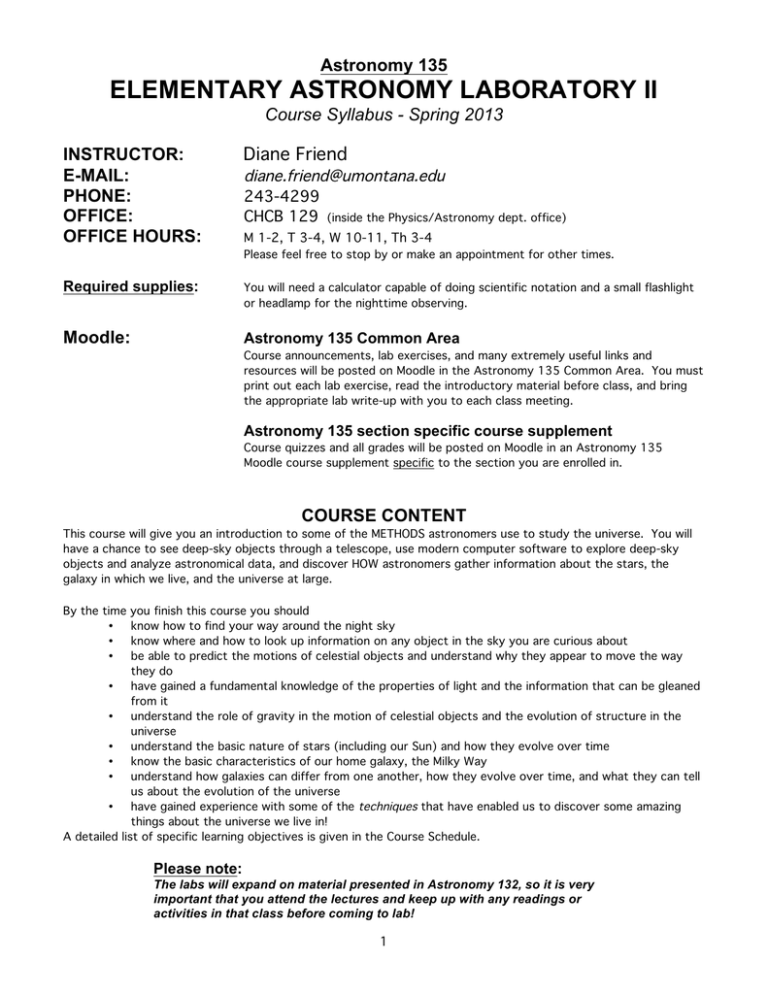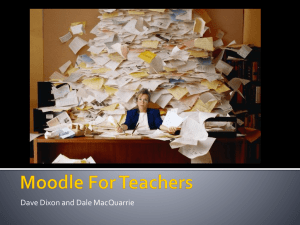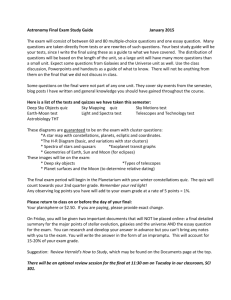ELEMENTARY ASTRONOMY LABORATORY II Astronomy 135 INSTRUCTOR: E-MAIL:
advertisement

Astronomy 135 ELEMENTARY ASTRONOMY LABORATORY II Course Syllabus - Spring 2013 INSTRUCTOR: E-MAIL: PHONE: OFFICE: OFFICE HOURS: Diane Friend diane.friend@umontana.edu 243-4299 CHCB 129 (inside the Physics/Astronomy dept. office) M 1-2, T 3-4, W 10-11, Th 3-4 Please feel free to stop by or make an appointment for other times. Required supplies: You will need a calculator capable of doing scientific notation and a small flashlight or headlamp for the nighttime observing. Moodle: Astronomy 135 Common Area Course announcements, lab exercises, and many extremely useful links and resources will be posted on Moodle in the Astronomy 135 Common Area. You must print out each lab exercise, read the introductory material before class, and bring the appropriate lab write-up with you to each class meeting. Astronomy 135 section specific course supplement Course quizzes and all grades will be posted on Moodle in an Astronomy 135 Moodle course supplement specific to the section you are enrolled in. COURSE CONTENT This course will give you an introduction to some of the METHODS astronomers use to study the universe. You will have a chance to see deep-sky objects through a telescope, use modern computer software to explore deep-sky objects and analyze astronomical data, and discover HOW astronomers gather information about the stars, the galaxy in which we live, and the universe at large. By the time • • • • • • • • • A detailed you finish this course you should know how to find your way around the night sky know where and how to look up information on any object in the sky you are curious about be able to predict the motions of celestial objects and understand why they appear to move the way they do have gained a fundamental knowledge of the properties of light and the information that can be gleaned from it understand the role of gravity in the motion of celestial objects and the evolution of structure in the universe understand the basic nature of stars (including our Sun) and how they evolve over time know the basic characteristics of our home galaxy, the Milky Way understand how galaxies can differ from one another, how they evolve over time, and what they can tell us about the evolution of the universe have gained experience with some of the techniques that have enabled us to discover some amazing things about the universe we live in! list of specific learning objectives is given in the Course Schedule. Please note: The labs will expand on material presented in Astronomy 132, so it is very important that you attend the lectures and keep up with any readings or activities in that class before coming to lab! 1 Past students of the lab have found that the more in-depth, practical experience of the laboratory course really helps their understanding of the material presented in the lecture. Take advantage of laboratory time to explore topics, think critically, and ask good questions! Although cloudy skies severely limit the amount of observing that we can do, we will try very hard to give everyone a chance to do some telescopic observing. We encourage you to take advantage of this to explore whatever is of interest to you! Please feel free to bring friends or relatives to our observing sessions if you wish. Throughout the course you will be expected to: 1. Read through the introductory material in the labs before the start of class. Make sure you understand the material from the lecture which relates to the lab. 2. Ask questions and come prepared to enter into discussion. If there are concepts that you are having trouble understanding, please come prepared to ask questions at the beginning of class. As you work through the labs, make sure that you understand the big picture, not just the procedural details. 3. Do your own work. Even when you collaborate with others on lab exercises, YOU will need to acquire a deep understanding of the material to do well on the lab quizzes that are the basis for much of your grade. GRADING There will be 13 labs over the course of the semester. You grade will be based on 12 of those. You can drop any ONE lab and the quiz based on that lab. Use this drop wisely! There will be NO make-ups for missed labs or quizzes. If you wish to do all 13 labs, I will drop your lowest lab and quiz score at the end of the semester when computing your grade. Missing more than one lab will have a sizeable impact on your grade! If you have an unusual, legitimate emergency, bring in documentation explaining your absence and I will be happy to work something out with you. If you have a legitimate reason for missing a lab and can tell me ahead of time, I may be able to get you in to one of the other lab sections for that one week. Your grade for this course will consist of two parts: Lab write-ups completed each week in class Moodle quizzes on each lab 50% 50% Lab write-ups: Before you leave lab, you must submit your lab write-up to your instructor to be checked off. Check + (100%) Check (80%) Check - (60%) Zero (0%) If you come to class each week course. Everything completed and basic understanding of topic demonstrated Some missing pieces and/or major misconceptions Deficient (significant omissions and/or limited critical thinking displayed) Absent, or you forgot to submit your lab write-up for grading and actively participate, you should be able to do very well on this part of the Quizzes: Quizzes for each lab will be online and taken outside of class. You will have from the end of your lab period to the following Tuesday at noon to complete each week’s quiz. Each quiz will have 10 questions and you will have 40 minutes to complete it. You will only get one attempt for each quiz. Immediately following submission of your answers you will receive your quiz score. Quiz answers and feedback will be available after the quiz closes. Quizzes are to be done alone, not with other students from the class. Most of the quiz questions will be directly related to what you did in lab, but there will also be some questions that ask you to synthesize what you have learned, or apply your knowledge to a slightly different situation. Those who think carefully about the lab topics, including their implications and broader applications, will do well on these questions. Your ability to think critically, ask good questions in class, and use what you have learned to make new predictions will be the discriminating factor between an “A” student and a “C” student in this class. Quiz responses will be graded and reported in the grade book (along with lab write-up grades) in each section specific Moodle course supplement. Please note that quiz credit will NOT be given unless you have attended the corresponding lab. You can check your grade anytime during the semester by finding the simple average of your current grades and applying the traditional grading curve: 90-100% A, 80-89% B, 70-79% C, 60-69% D, less than 60% F. 2 LAB SCHEDULE WEEK DATES 1 Jan 29-31 EXPERIMENT Lab 1 Course introduction; Star Maps: Part I; Planetarium Check out some of the many observing links under the Lab 1 tab in Moodle! 2 Feb 5-7 Lab 2 Sky Simulation Software 2 Feb 4-6 For backup dates, see the Astronomical Observing tab In Moodle. 3 Feb 12-14 Backup observing dates 4 Feb 19-21 Know what is currently up in the night sky, the basic motions of stars and planets, and how to use a star chart to locate objects and investigate how they move. Sky simulation software If you have a laptop, you may want to load SkyGazer or Stellarium (see link in Moodle) onto your computer and bring it to class with you. (evening) QUIZ LOCATION The night sky and star CHCB 13 charts Night Sky Observing CHCB 13 You will need to be able to use the software to find out what is in the sky at any date and time, discover where and when objects can be seen, and understand the motion and appearance of objects over time as seen from different locations. NO QUIZ for this lab. Skaggs Roof You will have some choice as to which date and time to attend. Sign-ups are available on Moodle. Sign up early to get the best choice of times. If your section is cancelled due to weather, sign-up again as soon as possible for one of the make-up dates. For all nighttime observing labs, call 243-4299 one hour before the start of your observing session for an update on sky conditions and whether or not the lab will be held. Do not call more than one hour before the start of your lab as weather can change rapidly and we will not necessarily make a decision prior to that. Lab 3 Gravity and Orbits IMPORTANT NOTE: Your entire grade for this lab will be based on a careful lab write-up that you will turn in to be graded. Gravity and orbits Feel free to load My Solar System onto your laptop and bring it to class with you. Link: http://phet.colorado.edu/sims/my-solarsystem/my-solar-system_en.html You will need a thorough understanding of Kepler’s Laws, know how gravity depends on mass and distance, and be comfortable modeling orbits for 2-4 bodies using the PhET My Solar System simulation. Lab 4 Light, Color, and Spectra Light, Color, and Spectra Understand emission, absorption, transmission, and reflection/scattering. Understand the composition of white light and how colors of light can be added or subtracted. Know why color filtering is so useful in astronomy. Be able to distinguish continuous and emission line spectra and know how spectra can be used to determine the composition of a gas. 3 meet outside east entrance to Skaggs observing session times are posted on Moodle CHCB 13 CHCB 13 5 6 Feb. 26-28 No Lab this week! Mar 5-7 Lab 5 The Sun The Sun Read through some of the many interesting links and background material posted on Moodle under the Lab 7 tab. 7 8 9 Mar 12-14 Mar 19-21 Mar 26-28 Lab 6 Exoplanets Exoplanets Apr 1-5 Apr 9-11 CHCB 13 Lab 7 Determining Age and Distance of Star Clusters H-R Diagrams of Star CHCB 13 Clusters Lab 8 Black Holes Black Holes You should understand how exoplanets are detected, how various properties of these planets can be deduced, and have a general idea of what has been discovered. Explore some of the fascinating links posted on Moodle! 10 11 CHCB 13 You should have a basic knowledge of solar activity and an understanding of its underlying cause. Know how physical conditions change with height above the solar “surface”, the basic layers and features of the solar atmosphere, and which features are related and why. SPRING BREAK Lab 9 The Milky Way Galaxy You should know- in detail, how to create, use, and interpret H-R diagrams. You should also have a good understanding of the importance and use of cluster color magnitude diagrams to our current understanding of stellar evolution. Be able to determine a cluster’s age and distance from its color magnitude diagram. The Milky Way Have a clear idea of the kinds of objects that populate the Milky Way, their distribution within our galaxy, and what their distribution tells us about how the galaxy has evolved over time, as well as our position in it. You should be able to reproduce an accurate 3D model of our galaxy. 4 CHCB 13 Quantitatively understand the relationship between wave velocity, frequency, and wavelength. Understand escape speed, how it differs from orbital speed, and how it is used to define the event horizon of a black hole. Understand how the gravitational influence of a black hole can be used to indirectly determine its existence and measure its mass. Know what is meant by gravitational redshift and be able to describe its effects on light and time. CHCB 13 12 13 Apr 16-18 Apr 30 – May2 Lab 10 Galaxies Galaxies Lab 11 Spiral Galaxies and Dark Matter Galactic Rotation Curves CHCB 13 You should be able to explain some differences between spiral galaxies and elliptical galaxies. How did you decide which was which? How can we estimate the size of spiral galaxies? How can we determine how far away the galaxy is? Know how to determine a galaxies motion with respect to us. CHCB 13 Understand the basics of circular motion. Be able to critically compare rotation curves for solid bodies, planetary systems, and galaxies and be able to use these curves to determine the distribution of mass. Why do galaxy rotation curves provide evidence for dark matter? What is the winding dilemma for spiral galaxies?. 14 15 16 Apr 23-25 Lab 12 Hubble’s Law and the Age of the Universe Hubble’s Law CHCB 13 What striking trend becomes visible when we plot recession speed versus distance for a large number of galaxies? What is Hubble’s Law? What is it telling us? How can we use it to find distances? How can we use it to find the age of the universe? How would a changing expansion rate affect these estimates? May 7-9 Final week of classes- no labs May 14-16 Finals week - Course grades will be posted on Moodle What’s happening in the night sky: We will post announcements of any especially interesting or unusual night sky events on Moodle. Moon phases this semester Meteor showers New moon: Feb. 9, Mar. 11, Apr. 10, May 9 Full moon: Jan. 26, Feb. 25, Mar. 27, Apr.25 Lyrids: peak the night of April 21/22 Eta Aquarids: May 5/6 Academic conduct statement: All students must practice academic honesty. Academic misconduct is subject to an academic penalty by the course instructor and/or a disciplinary sanction by the University. All students need to be familiar with the Student Conduct Code. The Code is available for review online at http://life.umt.edu/vpsa/student_conduct.php. ADD/DROPS: The last day to add/drop on Cyber Bear is Friday, February 15. The last day to use a Drop/Add form to drop or change grading option, with the signatures of your instructor and advisor is Monday, April 8. A drop, or change of grading option after April 8 requires the signature of the Dean and written documentation of exceptional circumstances. EQUAL ACCESS: A fair and inclusive learning environment benefits us all. I encourage students from different cultural backgrounds, students for whom English is not their native language, and/or any student who has a disability that may adversely affect their academic performance to contact me within the first few days of class to discuss appropriate accommodations. If you think you may have a disability and have not registered with DSS, please contact them in Lommasson 154, call (406) 2432243, or view the DSS website at http://life,umt.edu/dss. The folks at DSS are very helpful! 5




